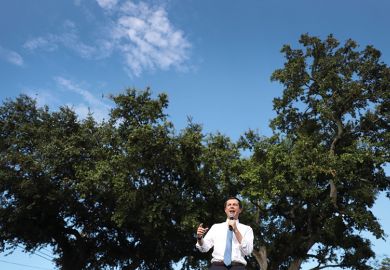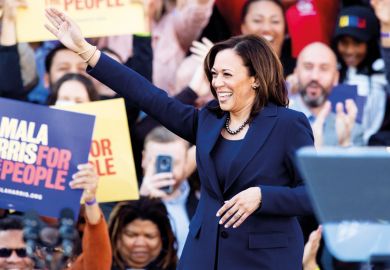In the Democratic presidential primary debate on 12 September, Kamala Harris brought up an important point about same-race educators. “If a black child has a black teacher before the end of third grade, they’re 13 per cent more likely to go to college,” she said. “If that child has had two black teachers before the end of third grade, they’re 32 per cent more likely to go to college.”
The social science study that Harris was referring to and other research like it, including my own, demonstrate the important effects of and challenges in diversifying faculties in primary, secondary and post-secondary education in the United States.
Here’s where Harris got her numbers
The statistics that Harris referred to come from research that used data from elementary and secondary schools in Tennessee and North Carolina to assess the effect of same-race teachers on students.
The study found that, for example, black students who were randomly assigned to a black teacher from kindergarten to third grade were 7 per cent more likely to graduate from high school and 13 per cent more likely to enrol in college than those black students in the same school who are not assigned a black teacher.
The study also concluded that white student outcomes were in no way diminished by being randomly assigned a black teacher.
The study tested two reasons for this outcome and had mixed results that could provide information on when and how the educational community should aim to diversify its faculty that go far beyond any moral motivations.
First, in its clearest results, the research demonstrated that black teachers had a positive “role model effect” on black students, allowing them to update their perceptions of what is achievable for a person who looks like them.
This explains why having just one black teacher improves student outcomes on all of the tested dimensions. However, other dimensions, such as taking a college entrance exam, were not improved by being exposed to additional black teachers.
The second tested the effectiveness of black teachers, who potentially have higher cultural competence than their white counterparts. A positive result could suggest that having more than one black teacher would improve each outcome even more than being exposed to just a single black teacher.
Results were less clear for this mechanism. While the data showed, as Harris’ point suggests, that black students exposed to additional black teachers are more likely to enrol in college, there were diminishing returns when it came to these students taking college entrance exams.
Overall, though, this study and others like it suggest that increasing faculty diversity will lead to better outcomes for students and for colleges.
Here’s the challenge
There is much social science evidence suggesting that increasing educational diversity will not be an easy or simple task. In schools and in higher education settings alike, the numbers of non-white faculty members are low, and the barriers to increasing those numbers are many.
In the primary and secondary school system, for example, only 7 per cent of teachers are black, while 15.4 per cent of pupils are black. In higher education, only 6 per cent of faculty members are black, while 14 per cent of college students are black.
Based on a straight-line projection of data from 1981 to 2007, the Journal of Blacks in Higher Education showed that “at the current rate of progress, it will take nearly a century and a half for the percentage of African American college faculty to reach parity with the percentage of blacks in the nation’s population”.
How can we overcome this challenge?
Research shows that there are several ways to address this problem. One of these strategies was also outlined by Harris in the same primary debate.
“I think most of us would say that we are not where we are without the teachers who believed in us,” she said. “I have offered in this campaign a proposal to deal with this, which will be the first in the nation, federal investment, in closing the teacher pay gap, which is $13,500 a year.”
Harris’ reference to a “teacher pay gap” is based on research that shows a significant difference – about 11 per cent – between teachers’ salaries and those of professionals with similar degrees.
Closing this gap could help to recruit more diverse teachers who may have chosen other career paths because of this pay differential.
In higher education, a similar relationship exists. My research shows that every $10,000 (about £8,000) increase in faculty pay in a college or university setting translates to a 1 per cent increase in the raw percentage of non-white faculty at that school.
Because of the already low numbers of non-white faculty, that seemingly small amount could translate to a nearly 17 per cent increase in faculty diversity year-over-year for some schools.
At Tulane University, where I’m pursuing my PhD, increasing faculty salaries by $10,000 a year, and thereby significantly increasing faculty diversity, would grow the school’s budget by only about 3 per cent.
This could have huge impacts for students in particularly racially homogenous departments: there currently isn’t a single tenure-track African American professor in the political science department where my doctoral programme is housed, for example.
It’s not just about money
Pay isn’t the only factor at play, however, and it shouldn’t be the only way the academic community tries to improve faculty diversity.
My research also shows that in higher education, student body diversity, the level of minority education in a school’s local area, and whether an institution has a mission to serve minority communities (historically black colleges and universities, for example) are all strong, positive predictors of a diverse faculty.
Harris and another presidential hopeful, Elizabeth Warren, have both proposed major investments in funding HBCUs, which themselves produce a large number of black professionals, including teachers.
But there are factors affecting teacher diversity that aren’t being explicitly addressed by the presidential candidates.
My research also highlights another important factor in whether under-represented minorities are hired for positions at predominantly white institutions (PWIs) in the US: hiring discrimination.
My analysis of data from my home state of Alabama shows that despite relatively high numbers of applications from qualified black professionals, African Americans are not being hired at anywhere near the same rates as their white counterparts.
All but one institution tested in the study, for example, failed the Equal Employment Opportunity Commission’s adverse impact test for racial discrimination in hiring.
Increasing faculty pay, then, isn’t and shouldn’t be a singular solution. Instead, only a holistic approach, and potentially even one that involves litigation against discriminatory hiring practices, will allow us to have the positive outcomes that research shows a diverse teaching population can provide.
Kamala Harris and Elizabeth Warren are on the right track when it comes to improving diversity in K-12 and higher education faculties. But their policies and talking points outline only the first steps towards achieving racial parity with the populations academia serves. We need to commit to the marathon that this process will be, not just the first few steps.
Lee Hedgepeth is a political development PhD student at Tulane University in New Orleans and an adjunct instructor in Delgado Community College’s adult education programme.
Register to continue
Why register?
- Registration is free and only takes a moment
- Once registered, you can read 3 articles a month
- Sign up for our newsletter
Subscribe
Or subscribe for unlimited access to:
- Unlimited access to news, views, insights & reviews
- Digital editions
- Digital access to THE’s university and college rankings analysis
Already registered or a current subscriber?




